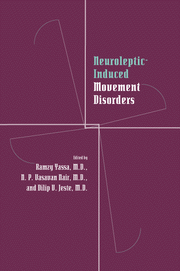Book contents
- Frontmatter
- Contents
- Contributors
- Preface
- Part I Historical perspective
- Part II Clinical aspects of tardive dyskinesia
- 2 Aging and tardive dyskinesia
- 3 Gender as a factor in the development of tardive dyskinesia
- 4 The Yale tardive dyskinesia study: a prospective incidence study among long-term outpatients
- 5 Vulnerability to tardive dyskinesia in schizophrenia: an exploration of individual patient factors
- 6 Tardive dyskinesia and affective disorder
- 7 Diabetes mellitus and tardive dyskinesia
- 8 Other factors in the development of tardive dyskinesia
- 9 Neuroleptic treatment and tardive dyskinesia
- 10 Anticholinergic drugs as factors in the development of tardive dyskinesia
- Part III Mechanisms underlying tardive dyskinesia
- Part IV Measurement of tardive dyskinesia
- Part V Tardive dyskinesia in different populations
- Part VI Other neuroleptic-induced movement disorders
- Part VII Treatment of tardive dyskinesia
- Index
3 - Gender as a factor in the development of tardive dyskinesia
from Part II - Clinical aspects of tardive dyskinesia
Published online by Cambridge University Press: 09 October 2009
- Frontmatter
- Contents
- Contributors
- Preface
- Part I Historical perspective
- Part II Clinical aspects of tardive dyskinesia
- 2 Aging and tardive dyskinesia
- 3 Gender as a factor in the development of tardive dyskinesia
- 4 The Yale tardive dyskinesia study: a prospective incidence study among long-term outpatients
- 5 Vulnerability to tardive dyskinesia in schizophrenia: an exploration of individual patient factors
- 6 Tardive dyskinesia and affective disorder
- 7 Diabetes mellitus and tardive dyskinesia
- 8 Other factors in the development of tardive dyskinesia
- 9 Neuroleptic treatment and tardive dyskinesia
- 10 Anticholinergic drugs as factors in the development of tardive dyskinesia
- Part III Mechanisms underlying tardive dyskinesia
- Part IV Measurement of tardive dyskinesia
- Part V Tardive dyskinesia in different populations
- Part VI Other neuroleptic-induced movement disorders
- Part VII Treatment of tardive dyskinesia
- Index
Summary
Ever since the syndrome of tardive dyskinesia was introduced into the literature more than 30 years ago, older age has been the only consistent risk factor confirmed by most authors (Smith & Baldessarini, 1980). However, several other factors, detailed elsewhere in this volume, have now been implicated.
Gender has been suggested to be an important factor in the development of tardive dyskinesia, and whereas some authors have concluded that women have a higher prevalence of tardive dyskinesia than do men, others have found no gender difference (Jeste & Wyatt, 1981). Elsewhere, we have reviewed, in detail, the studies that discussed and compared the prevalences of tardive dyskinesia for the two genders (Yassa & Jeste, 1992). Only articles published in English or French (or in other languages, if a detailed summary was provided in English or French) were reviewed. We found 93 English or French prevalence studies published prior to the end of 1989. To be included in our review, a study had to meet the following criteria:
report on 50 patients or more. The study by Crane and Smeets (1974), a study of 39 patients, was therefore excluded.
include both genders in its sample. We excluded three women-only studies (Uhrbrand & Faurbye, 1960; Pryce & Edwards, 1966; Edwards, 1970) and two studies of men only (Dynes, 1970; Goldberg et al., 1982).
include the numbers of men and women affected by tardive dyskinesia. Eleven studies were excluded (Paulson, 1968; Yagi et al., 1976; Bell & Smith, 1978; Alexopoulos, 1979; Gardos et…
- Type
- Chapter
- Information
- Neuroleptic-induced Movement DisordersA Comprehensive Survey, pp. 26 - 40Publisher: Cambridge University PressPrint publication year: 1996

